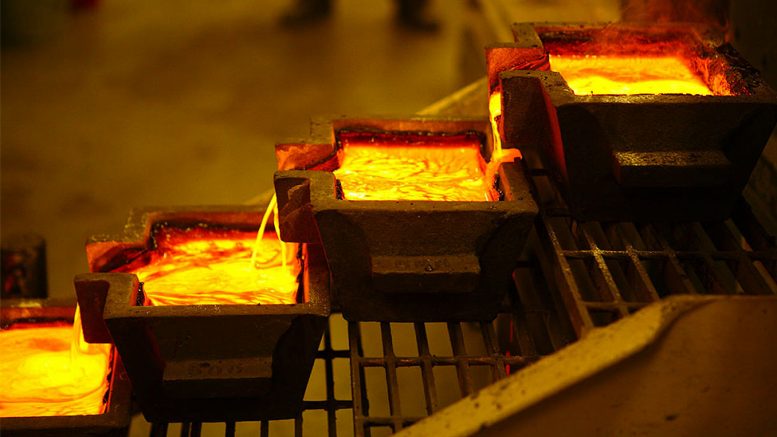
Silver said the idea for the talk started when he asked the question “What happened to the gold deposits of 1989?” during a keynote speech in 2019 at the 30th anniversary of the Denver Gold Group, which he founded in 1989.
He first started by developing a database containing 2,748 gold deposits dating back to 1989.
“I then systematically went through over 5,500 company websites on the Goldsheets mining directory to update old deposits and add new deposits,” he explained. “Missing data was fleshed out using The Northern Miner and the Mines Handbook, with specific data from Stockwatch, and I backfilled with data extracted from hundreds of NI 43-101 reports and company press releases,” he said.
According to Silver’s analysis, today’s gold deposits are larger in tonnage and have lower grades
Silver noted that many gold deposits disappear because they are either mined out, abandoned, or returned to their private owner. Deposits also change names, and operators often don’t disclose the termination of operations or dropped properties.
“In addition, the multiple expansions of large porphyry copper mines means that many [operators] no longer consider their precious metals as material and so don’t report them,” he said.
He continued, older deposits are also often incorporated into more significant deposits due to land consolidation and the push for larger mines, citing the Canadian Malartic mine, jointly owned by Yamana Gold (TSX: YRI; NYSE: AUY) and Agnico Eagle Mines (TSX: AEM; NYSE: AEM), and the Super Pit in Western Australia operated by Kalgoorlie Consolidated Gold Mines, a joint venture between Barrick (TSX: ABX; NYSE: GOLD) and Newmont (TSX: NGT; NYSE: NEM), as examples.
In 1989, approximately 2.53 billion oz. of gold were produced from the 2,748 deposits, which, by 2020, had increased to 2.63 billion oz., Silver said. Although the number of million-plus-oz. deposits had declined from 414 in 1989 to 355 in 2020, the total gold produced from these deposits have increased from 2.1 billion oz. to 2.5 billion oz. over the same period.
Although the proportion of million-plus-oz. deposits compared to total deposits have declined from 15% to 13%, he said, the share of gold production from these deposits compared with total production has increased from 83% to 96%.
Of the 2,748 deposits in 1989, 27.3% (750) went into production and 25.8% (710) are still known to host resources, he added. (Silver noted that when using “resources,” he is referring to combination of measured, indicated, and inferred resources.)
“In 1989, most of the deposits were in Canada and the U.S.,” Silver said. “If you add in Mexico [in fifth place], then North America comprised 58% of the total deposits globally but only about 21% of the total gold production that year.”
South Africa, he continued, was the fourth-highest country (after Australia) for the number of deposits in 1989 and produced over 600 million oz. of gold, the highest amount of any country (Canada placed second at nearly 300 million oz.) that year. However, South Africa’s gold production dropped to about 300 million oz. in 2020 and is now the world’s fourth-largest producer, with Canada the number one producer at approximately 600 million oz.
Outside the top 11 producingcountries globally, the rest of the world accounted for over 600 million oz. of gold production in 1989 and over 1.6 billion oz. in 2020. Silver noted that of those countries, Ethiopia had increased its number of deposits by 400%, Finland by 400%, Saudi Arabia by 367%, Romania by 233%, and Armenia by 200% over this period.
“The database showed that 23 deposits representing a total of 147 million ounces of gold have been known about for 30-plus years but have never been placed in production,” he said. “Fifteen of these deposits are located in Canada, with six in the U.S., one in Peru, and one in Chile.”
According to Silver’s analysis, today’s gold deposits are larger in tonnage and have lower grades. They contain more ounces compared with deposits in 1989, which, he said, is primarily due to the higher gold prices and lower operating costs today.
He calculated that the average grade for deposits in 1989 was 1.37 grams gold per tonne, with those same deposits showing an average grade of 0.56 gram in 2020. Whereas the total tonnage for deposits in 1989 was 54.6 billion tonnes containing 2.4 billion oz. of gold, today they have a total tonnage of 133.1 billion tonnes and contain 4.1 billion ounces.
When new discoveries were included in the calculation, taking the total number of deposits to 3,721, total tonnage was estimated to be 244.6 billion tonnes grading 0.52 gram gold containing 4.1 billion oz. of gold, he said.
“What you see here is classic resource management,” Silver explained. “By the end of 1989, the gold price was about US$409 per oz., and by the close of December last year it was US$1,860 per ounce. So, when gold prices are low, you mine high grades, and when gold prices are high, like today, you mine low grades.”
The mix of mining methods has also changed over the past 30 years, with the proportion of open pit mines increasing by 20% and the share of million-plus-oz. deposits that use open pit methods up 35% over the same period, despite the impacts of open pit mining on the environment, he said.
Silver acknowledged that, although his database shows that there is about 4.4 billion oz. of gold resources today, this figure does not include gold from companies that are mining platinum group elements, which, he said, could account for another million ounces, or gold mined at porphyry copper deposits, which can typically contain anywhere from a million to 10 million oz.
“When you roll all this together, it amounts to probable resources of about 5.0 billion oz., which, if mined at 100 million oz. per year provides for a 50-year supply,” he said. “Improvements in technology, which lead to lower operating costs and lower cut-off grades, combined with increases in gold prices could see a lot more gold being extracted.”
(This article first appeared in The Northern Miner)




